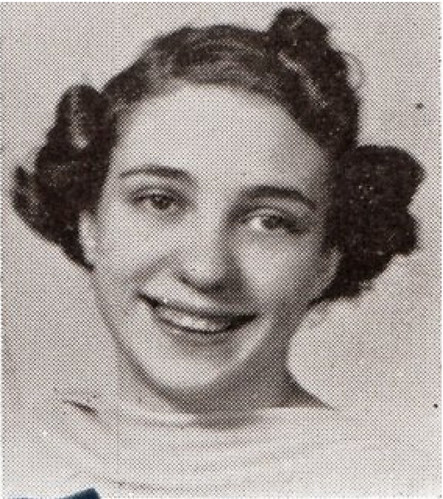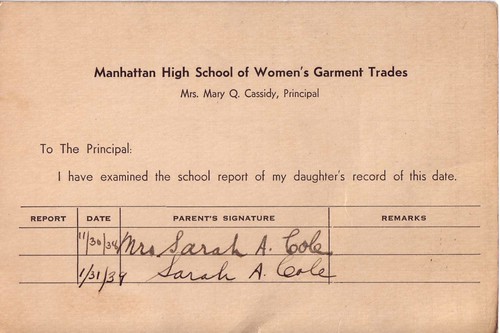
Yesterday I told you a bit about Anneliese Stark, whose report card I found on the web while doing some research. The photo you see above shows her in 1940, when she was 19.
Anneliese -- whose name is now Anneliese Smith -- now lives in an assisted-living facility in Baltimore. She is the oldest living graduate of the Manhattan Trade School for Girls that I have encountered (although the school had changed its name to the Manhattan High School of Women's Garment Trades by the time she attended). Her grandson, Frank Diller, who had posted her report card on his blog, graciously arranged for me to interview her over the phone a few weeks ago. We talked for a little over 15 minutes. Here's how it went:
Permanent Record: Frank, your grandson, explained to me that when you attended the trade school, you were living in a home for girls [essentially an orphanage], is that right?
Anneliese Smith: Yes, that's right, after my mother died.
PR: Was that home in Manhattan?
AS: It was in the Bronx. 318 Mosholu Parkway.
PR: You remember the address!
AS: Yes, it was a millionaire's home, and they took care of 28 girls. They were 12 to 18 [years old]. I think it was about five or ten millionaires who sponsored that home.
PR: Were you already attending the trade school when you began living there?
AS: No. I had missed two years of school because I'd been taking care of my mother, who was sick. [Anneliese's mother died of throat cancer when Anneliese was 13.] Nobody even bothered to see whether you were in school at that time. And then when I went into the home, that's when I started school again. They sent me right to the trade school.
PR: Did any of the other girls at the home go to the trade school?
AS: No, I was the only one.
PR: Do you know why they decided to have you go to a trade school, instead of a conventional high school?
AS: I guess because I had missed so much time.
PR: And when you entered the school, what trade did you choose to focus on?
AS: Well, I was interested in cooking, baking, stuff like that. So it was cafeteria management, I think it was called. But I took all the other courses also -- math, science, all that stuff. It's all there on my report card. I hadn't seen that in years until my grandson found it when I was moving.
PR: They were still teaching sewing and dressmaking at that point, right?
AS: Oh, yes. And they had beauty shop also. Teaching how to cut hair and all that.
PR: But you were more interested in cooking.
AS: I didn't really know what I wanted, honestly.
PR: Well, very few people do at that age. What do you remember about the school? Do you think it was a good school, and a positive experience for you?
AS: I think it was, yes. I enjoyed being there. The teachers were very nice. One time they took us up to Rye -- Rye, New York -- where there were rides and things like that.
PR: Oh, Rye Playland?
AS: Yes, that's right. That's where we were. We had a great time. We had a picnic first, and then we enjoyed the rides.
PR: It was still exclusively a girls' school at that point, right?
AS: Yes it was, mm-hmm.
PR: And the teachers and instructors -- were they all women?
AS: Yes, I think they were, yes.
PR: So there were really no men anywhere in this building.
AS: No, not really.
PR: After you finished your education, did the school help you find a job?
AS: No, I went to Pratt Institute for a year.
PR: Oh! And what did you study there?
AS: Same thing -- cafeteria management. But I never followed through with it.
PR: You never went into that field?
AS: No. I went into the service [the Army] when I was 21. After that, I did work at Stouffer's restaurant in New York for a while.
PR: Was that before you went into the service?
AS: Yes. It was on Fifth Avenue -- I think near 42nd Street. I don't know if it's there anymore.
PR: I don't think it is.
AS: But Stouffer's dinners!
PR: Yes, those are still around. What did you do at the restaurant?
AS: Whatever was needed. I was in training. I worked there for, oh, I guess it must have been almost a year. And after I came out of the service, I worked at Chase National Bank.
PR: Later on, when you were married and cooking for your family, do you think the skills and some of the things you learned in school…
AS: Oh yes, it was helpful.
PR: So even though you didn't go into a restaurant career, your experience at the trade school helped you in later life.
AS: Yes, it did.
PR: Did you maintain any kind of contact with the school over the years?
AS: No, I didn't.
PR: I've seen your report card, but do you know if you saved any other artifacts or paperwork from your time at the school?
AS: I have my yearbook, but that's about all.
PR: Really?
AS: My grandson has it someplace, yes.
PR: Wow. I'll have to ask him about that. Would it be okay if he showed it to me?
AS: Yes, that would be fine.
PR: Anything else you remember about the school, maybe about the building itself?
AS: It, it -- it didn't look like a school. It looked more like a warehouse, I think. It didn't feel very scholastic. But they had a cafeteria on the first floor, where people would come in to eat, and we served ’em.
PR: Well, I don't know if it looks like a warehouse, but the building is still there, and it's still a school, although it isn't a trade school anymore. Now, when they were teaching you cafeteria management, what sorts of things were they teaching you?
AS: We did all the cooking, and then we served the lunch.
PR: So you were feeding the other students?
AS: No, we were feeding people who'd come in from outside.
PR: Oh -- so people in the neighborhood could go to a coffee shop, or a diner, or whatever, or they could come get lunch from you?
AS: Yes. We always had soup and salads, hot food. Rolls, cakes, and pies.
PR: And would you be supervised by the school's staff?
AS: Yes. Miss Johnston.
PR: Would you or the other students come up with recipes, or were they given to you?
AS: They were given to us.
PR: And at that time, were you thinking, "This is good food, we're serving a good meal"?
AS: Well, at the time I was upset because I'd lost my mother, and I went on a hunger strike. So that was rough on a teacher. She had to coddle me and make me eat.
PR: Now, you were commuting all the way from the Bronx to East 22nd Street. Was that a long commute?
AS: Yes, it took about 45 minutes to an hour. I used to ride the train, the subway.
PR: On the back of your report card, there are signatures from…
AS: From Miss Cole.

PR: And who was she?
AS: She was the superintendent of the home. She was wonderful -- oh, she was so good to me.
PR: And she signed your report card because she was your legal guardian.
AS [starting to sound a little tired]: Yes.
PR: I want to thank you so much for sharing your time and your stories with me.
AS: Oh, you're welcome. I hope I've helped you a little bit, I don't know.
PR: Oh, you have. Thanks again.
And there we are. I actually learned a fair amount from Anneliese. For example, I hadn't known that the school was offering cafeteria management or cosmetology instruction in the late 1930s. I also didn't realize the school had a retail lunch operation. Some years earlier, when Manhattan Trade's vocational training centered on garment work, a small dress shop, selling the students' creations, had operated on the school's first floor. Perhaps the lunch business replaced the dress shop as the school's vocational focus shifted, or perhaps the two retail outlets coexisted. Another mystery for another day.
After speaking with Anneliese, I asked Frank about the yearbook. He found it and was then kind enough to loan it to me. You can see Anneliese's senior photo at the bottom-right corner of this spread. Unfortunately, the yearbook doesn't have much additional information about what the school was like during this period -- it's mostly just head shots, a few poems and essays, and a long list of boosters.
One last thing: Frank told me that when Anneliese turned 16, Miss Cole -- her guardian at the orphanage -- recommended that she visit her father, whom she hadn't seen since her parents had divorced years earlier. As Frank described it to me, "She went to his apartment and knocked on the door. Her father opened the door and promptly shut it in her face. Anneliese heard a woman in the apartment ask who was at the door. 'No one,' her father replied."
Frank has assured me that it's fine to share this story, but I couldn't bring myself to ask Anneliese about it. It just seems too heartbreaking. So here's a teen-ager who had to overcome the death of her mother and the rejection of her father, yet managed to build a life and a family for herself. It's an inspiring story -- she must have been very strong. My sense of it is that she still is.

No comments:
Post a Comment